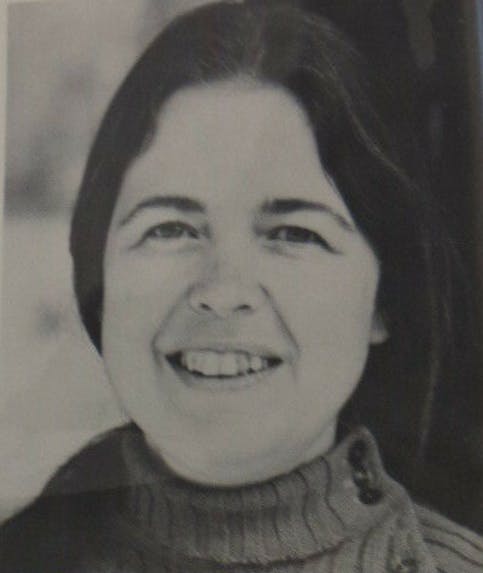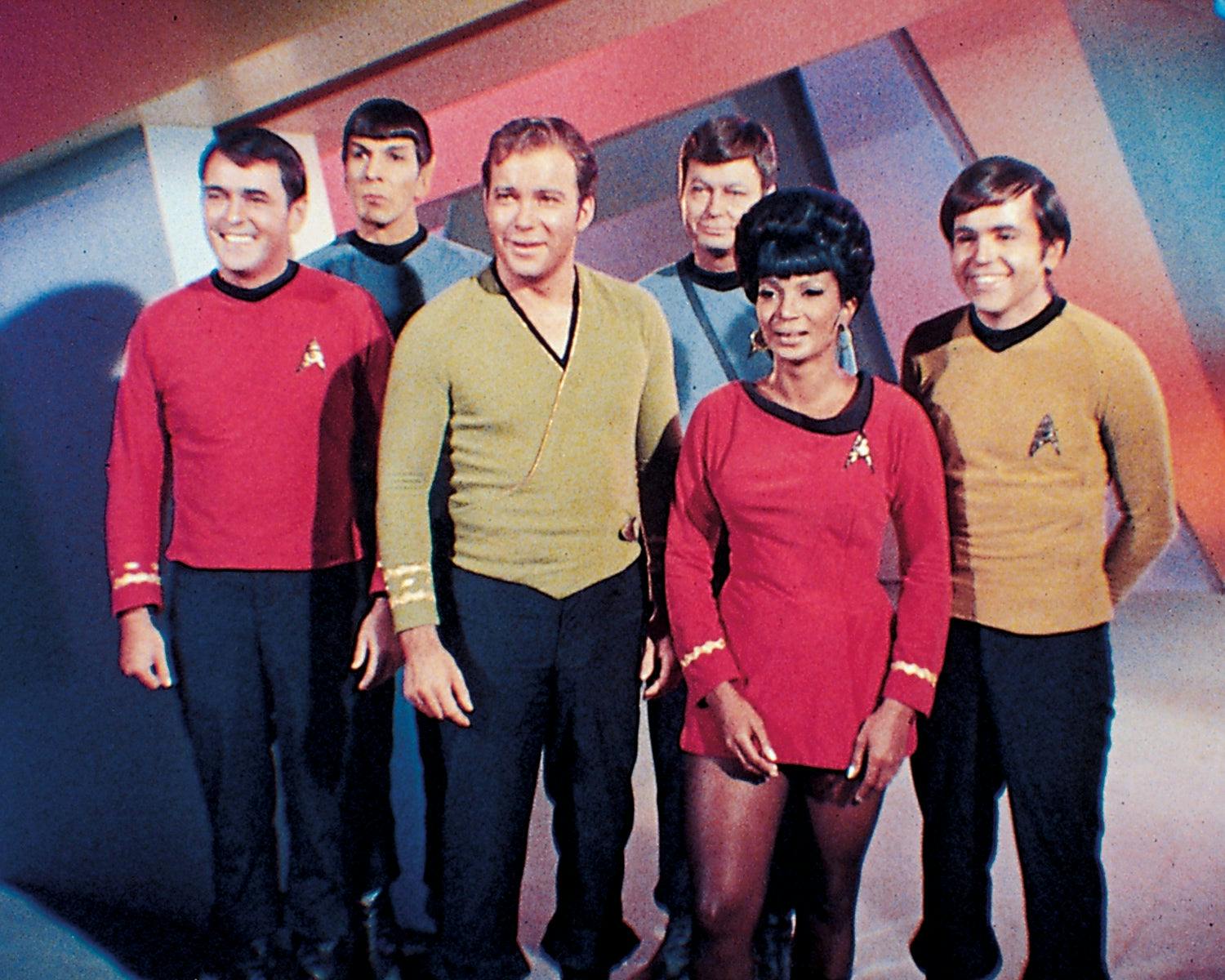Published Mar 8, 2021
Karin Blair: The Spirit Haunting Star Trek Scholarship
How one woman changed the course of academic study of Star Trek

StarTrek.com
There is a book titled Meaning in Star Trek. It can be found all over used book sites, and the cover of my worn, paperback copy boasts Leonard Nimoy’s approval: “Thorough, intelligent, and meaningful.” The cover insists the book will show us why Star Trek amassed a devoted fanbase, and, just inside, Gene Roddenberry says the book even taught him about Star Trek and himself. The book posits that Star Trek inspires hope and reaches out with compassion to the alien outsider in all of us. In eleven chapters it offers the most comprehensive analysis of the original series I’ve found, mentioning all 79 episodes. It examines Kirk, Spock, and McCoy in individualized detail. It examines the portrayal of women in the series and examines Star Trek as a modern myth. For someone analyzing Star Trek in an academic setting, it is invaluable.
But Meaning In Star Trek did not spring, fully formed, into the world upon its release in 1977. Someone had to do the research, construct the analysis, watch all the episodes, and write every word. That someone is Dr. Karin Blair.
Karin Blair began her studies at Wellesley College and Oakland University, eventually earning a Masters in English from the University of Geneva, and a Doctorate in Psychology and Women’s Studies from the Union Graduate School. She taught English in Geneva after her small family moved there in 1970. When they returned to the States in the late 1970s, they found themselves untethered from the culture. When they needed it most, they found a cultural foothold in Star Trek. Watching reruns of the show and discovering its devoted following, Karin and her family fell in love with the crew of the Enterprise and the 23rd century.

StarTrek.com
Meaning in Star Trek’s preface makes clear the dedication behind the book. Dr. Blair’s research took her to the hearts of the Star Trek community, from major players in the creation of Star Trek like Gene Roddenberry and D.C. Fontana, to the dedicated fans like the ‘Star Trek Welcommittee,’ who were organizing and recording a fandom of unprecedented proportion.
Blair’s work was also unprecedented. Academic study of popular television was just beginning. At the time, comparable books were focused on the inner workings of the show, or the fandom. But, these fan-centric books like Meaning in Star Trek promised to explain the growing fandom. This trend is obvious on Meaning’s cover, which promises insight on “Trekkies,” but Blair was not interested in what Trekkies were up to. She focused on what Star Trek offers the viewer, and its cultural place. Meaning analyzed the show itself over the phenomenon.
Using her background in folklore and psychoanalytic theory, Karin Blair presents Star Trek as a modern myth and roadmap for the future. She centers Mr. Spock, specifically, as a lens for considering difference and the alien. Blair reads Spock as a role model for dismantling binaries and as a bridge between human and alien. In Spock she finds the strong and the sensitive, the familiar and the strange, and much in between. She then extrapolates how we, as real-world humans, might improve. She also looks into the presentation of women and femininity in Star Trek, finding elements both reductive and unique, in the matriarchs and potential love interests.
As an undergraduate I wrote a paper on Dr. Carol Marcus, comparing the character in The Wrath of Khan to Into Darkness, and I found Blair’s article, “Sex and Star Trek” invaluable in my research. Written just before Wrath of Khan premiered, it offers a blueprint of women in Star Trek up to that point, against which I could analyze Carol Marcus. I was immediately indebted to Dr. Blair.

StarTrek.com
When I returned to Star Trek research I sought out Blair’s work, and was excited to find Meaning in Star Trek. Studying and analyzing Star Trek had me considering an academic career, and to hold in my hands this woman’s book analyzing The Original Series was hugely inspiring. I found myself asking: Who is Karin Blair?A quick Google search of Karin Blair doesn’t bring up much but her academic work and a small page on the wiki Memory Alpha. The information I found was essentially a summation of Meaning’s preface and author bio: she’s an academic who worked and lived in Geneva. But where was Blair now? Was she alive, maybe enjoying retirement somewhere? Could I contact her and express how much her work inspired me? I didn’t have time to dig deep enough to find her while juggling classes, but Karin Blair continued to haunt me, and the bibliographies of Star Trek scholarship.I inevitably returned to my search for Karin Blair, and though it took a variety of search terms, I slowly compiled a better picture. Testing any terms to try and find something, I tried “Karin Blair forum,” aiming further back in online Trekkie history.
I didn’t find the forums I expected, but I found a lead — an article in the academic publication, Forum: A Journal for the Teacher of English Outside the United States. There was nothing Star Trek related about analyzing the nuances of English past, present, and future tense, but there was an author bio. Some information was familiar, and I found names of her alma maters, teaching positions, and publications, including Meaning In Star Trek and a journal: ANIMA. My next lead. This bio also featured the only photo of Dr. Karin Blair I’ve found: the black and white headshot on Meaning’s dust jacket.
A year before the Forum article, Blair published “Sex and Star Trek.” In barely six pages, it distills two primary interests from Meaning, the portrayal of women in Star Trek and Mr. Spock’s appeal, and reevaluates them for The Motion Picture. She breaks down the presentation of women in The Original Series like this: every woman that appears is either dead or gone at the end of the episode, beholden to a male character (love interest, husband, brother, father), or objectified, serving more as a (sexy) narrative prop than a character with agency. Most women are all these things, including Ilia in The Motion Picture. From here Blair asks: if women in Star Trek are objects, what can women connect with in the show and in their fanfiction?
To answer, she analyzes Mr. Spock’s appeal. She stipulates that Spock features heavily in women’s fanfiction because he is a unique, appealing love interest as well as an inherent feature in Trekkie power fantasies. To put oneself in the place of Kirk includes having the invaluable first officer. This look at the space women carved into the fandom is inventive, and these ideas are often cited in similar works, from Harvey Greenberg’s “In Search of Spock” (1984) to Patricia Vettel-Becker’s “Space and the Single Girl” (2014).
As I continued my research, I found some pages of ANIMA: The Journal of Human Experience (1974-1973). The only direct references to Karin Blair that I found were in the list of editors, and I found her husband’s name: John. The grainy, photocopied nature of the work I found brought back the question: was she even alive? The morbid work of searching obituaries turned up two Karin Blairs, but they had only names and dates, nothing verifiable.
The most recent article I found by Blair was “Star Trek Old and New: From the Alien Embodied to the Alien Imagined” in 1997. It builds on her analysis of Spock as a bridge between the familiar and the other to discuss how The Next Generation, Deep Space Nine, and Voyager have handled the other and traditional binaries. Dr. Blair examines how Star Trek continues to negotiate these ideas, just as Spock did, citing episodes and characters that engage with binaries like human/alien, male/female, good/bad, young/old, and, centrally, us/them. It’s a fitting expansion of her Star Trek work, encouraging serious analysis of the franchise’s most inspiring ideas.
I kept digging, searching for more of Blair’s work and finding mostly citations. Then I uncovered “Karin Blair's Comparative Civilizations Project In 1998: Theatrical Traditions Along The Silk Route,” buried in a journal on the sociology of leisure. The author was Dr. John G. Blair, her husband.
As he contextualized the research, I found out more about Blair’s life. After their time in Europe, the Blairs taught in Beijing in the late 1980s. Karin Blair also traveled in India, and her experience of diverse cultures inspired her, again, to analyze questions about the familiar and the foreign. She was comparing theatre in India, China, and The West: their similarities and differences, and how the parallel study of all three can avoid binary conclusions.

StarTrek.com
But I was stuck on the opening paragraph. In John Blair’s introduction to his wife’s work, I found my answer: Dr. Karin Blair had died of cancer on January 30th, 1998, at the age of 57.
This matched one of the obituaries and explained her sparse digital record. The confirmation of her untimely passing stuck with me as though it was new. But another question arose: could I still tell someone how much she inspires me?
I looked for Dr. John G. Blair, and found him still hard at work in academia, with a public email address. I also began outlining this piece to share how important Dr. Karin Blair’s work is to me and others.
Dr. John Blair was enthusiastic and kind in his response to my email. He confirmed much of what I’d found, and my introduction to Blair and the book’s inception is largely paraphrased from him. He wasn’t shy about the family’s love of Star Trek, telling me, “The whole show was a revelation to us because it implied a whole new way of voyaging through life. Its popularity suggested that many others were attracted as well, despite lacking our years far away in Geneva.”
He also mentioned his daughter, Dr. Ann Blair, head of Harvard University’s history department, and I reached out to her. Though she admitted she wasn’t especially involved with the Star Trek work at the time, Ann Blair said her mother “was a wonderfully creative person and excelled at what we now call ‘thinking outside the box,’ at a time when I gather (from wikipedia) that that expression was just starting to catch on … in any case it suits her very well!” What an excellent distillation of the picture I managed to gather of Dr. Karin Blair, a woman on the cutting edge of her field(s), turning an inventive and analytical mind to all that interested her. Ann Blair also offered a photo of Karin Blair in 1997, a valuable supplement to her author photo.
A Timeline Through the Star Trek Universe
Just inside Meaning in Star Trek’s cover, there is a longer version of Leonard Nimoy’s quote, which accurately concludes, “...it will add much to the body of literature on the subject.” Blair’s analysis of the original Star Trek episodes serves as a touchstone for continuing analysis of Star Trek. I would like to thank her, somehow, for the academic groundwork she laid for myself and others. I am also grateful to John and Ann Blair. I’m glad I could get their help in sharing Karin Blair with the community. She is one of many half-forgotten women who built this fandom as we know it, and who inspire us to keep analyzing, creating, and engaging with Star Trek.
Anna Dodds (she/her) is a copyeditor, online content creator, and published Star Trek scholar. She can be found at @AnnaDodds42 on twitter.

